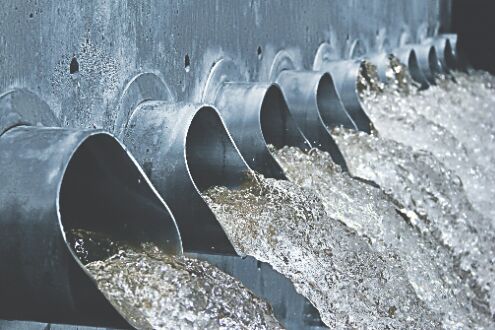Murky situation
Lack of data makes wastewater containment in developing countries an uphill task

To limit the spread of disease and reduce environmental pollution, human waste (excreta) needs to be safely contained and effectively treated. Yet, 4.2 billion people, more than half of the world's population, lack access to safe sanitation.
In developing countries, each person produces, on an average, six litres of toilet wastewater every day. Based on the number of people who don't have access to safe sanitation, that equates to nearly 14 billion litres of untreated faecally-contaminated wastewater created every day. It equals 5,600 Olympic-sized swimming pools.
This untreated wastewater directly contributes to increased diarrhoeal diseases, such as cholera, typhoid fever and rotavirus. These diseases are responsible for 2,97,000 deaths of children under five years age annually, or 800 children every day.
The highest rates of diarrhoea-attributable child deaths are experienced by the poorest communities in countries including Afghanistan, India, and the Democratic Republic of Congo. The problem is further compounded by the lack of reliable data.
Worsening situation
Inadequate sanitation is equally bad for the environment. An estimated 80 per cent of wastewater from developed and developing countries flows untreated into environment, fouling natural ecosystems and disrupting aquatic life due to excess of nutrients present in them. The world's most diverse coral reefs in tropical developing countries are facing such threat, more evidently in countries like Indonesia and the Philippines. The damage inflicted by raw wastewater on corals is severe. This stunts coral growth, causes coral diseases and reduces their reproduction rates.
The challenges of climate change will exacerbate our sanitation crisis, as increased rain and flooding will inundate sanitation systems and cause them to overflow. Pacific Island nations are particularly vulnerable because of the compounding impacts of rising sea levels and more frequent, extreme tropical cyclones.
Meanwhile, increased drought and severe water scarcity in other parts of the world will render some sanitation systems, such as sewer systems, inoperable. One example is the mismanagement of government-operated water supplies in Harare, Zimbabwe leading to the failure of the sewerage system and placing millions at risk of waterborne diseases.
Even in more developed countries like Australia, increased frequency of extreme weather events and disasters, including bushfires, will damage some sanitation infrastructure beyond repair.
Global targets
Improving clean water and sanitation have clear global targets. Goal six of the UN's SDG seeks to achieve adequate and equitable sanitation for all and halve the proportion of untreated wastewater. The absence of reliable data on the number of properly managed sanitation systems, particularly from developing countries, makes the target an uphill task
Individual studies provide small amounts of information on whether some sanitation systems are safely managed or not but are inadequate in size and scale.
Missing data
A big reason behind the missing data is the large range of sanitation systems and their complex classifications. For example, in developing countries, most people are serviced by on-site sanitation such as septic tanks or pit latrines. But the lack of adherence to construction standards in nearly all developing countries means most septic tanks are not built to safety standards to treat faecal sludge.
The use of incentivised 'non-standard' septic tanks is very common in developing countries. From my current research in rural Fiji, I've seen reduced tank sizes and the use of alternative materials (old plastic water tanks) to save space and money in material costs. Excreta can leach freely into the surrounding environment from these tanks. These tanks are further incentivised due to the lack of sealed chambers reduces the accumulation of sludge, delaying costly emptying fees.
A standard septic tank is designed to be de-sludged periodically, where the settled solids at the bottom of the tanks are removed by large vacuum trucks and disposed of safely.
Another key challenge with data collection is how to determine if the sanitation infrastructure is functioning correctly. Even if the original designs are built to a quality standard, there remain significant deficiencies in operational and maintenance activities leading to improper functioning of the system.
Further, the terminology is a constant point of confusion. Households — when surveyed for UN's Sustainable Development Goal data collection on sanitation — will say they do have a septic tank. But in reality, they're unaware they have a non-standard septic tank functioning as a leach-pit.
Fixing the problem
Achieving SDG six requires nationally representative data sets. The following important questions must be answered, at national scales in developing countries:
For every toilet, where does the excreta go? Is it safely contained, treated on-site, or transported for treatment? If the excreta is not contained or treated properly after it leaves the toilet, then how far does it travel through the ground or waterways? When excreta is removed from the pit or septic tank of a full on-site latrine, where is it taken? Is it dumped in the environment or safely treated? Are sewer systems intact and connected to functioning wastewater treatment plants that release effluent (treated waste) of a safe quality?
Presently, the sanitation data collection tools used by the UN uses for its SDGs don't completely answer these critical questions. More robust surveys and sampling programmes need to be designed along with resource allocation for government sanitation departments for a more thorough data collection strategy.
We also need a coordinated investment in sustainable sanitation solutions from all stakeholders, especially governments, international organisations and the private sector. This is essential to both protect the health of our own species and all other living things.
The writer is a lecturer in environmental and humanitarian engineering, University of Sydney. Views expressed are personal



